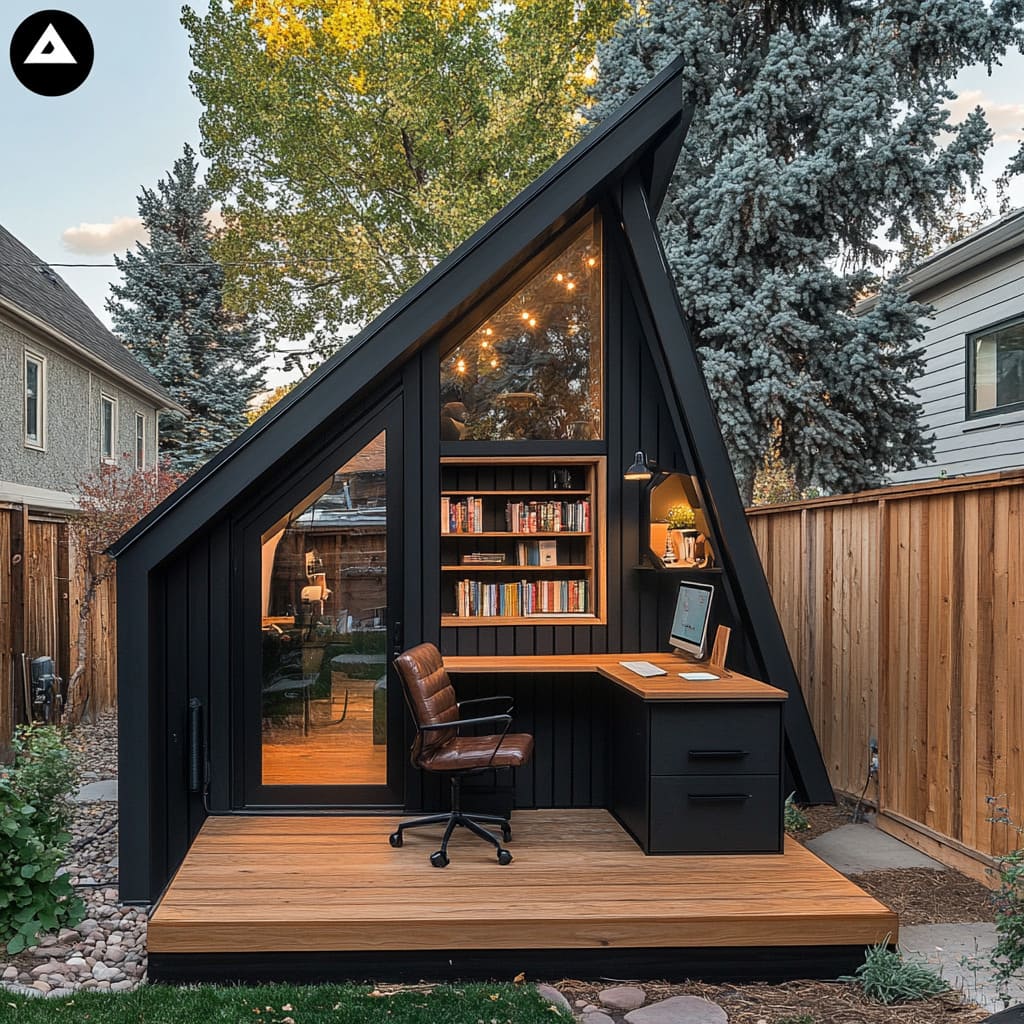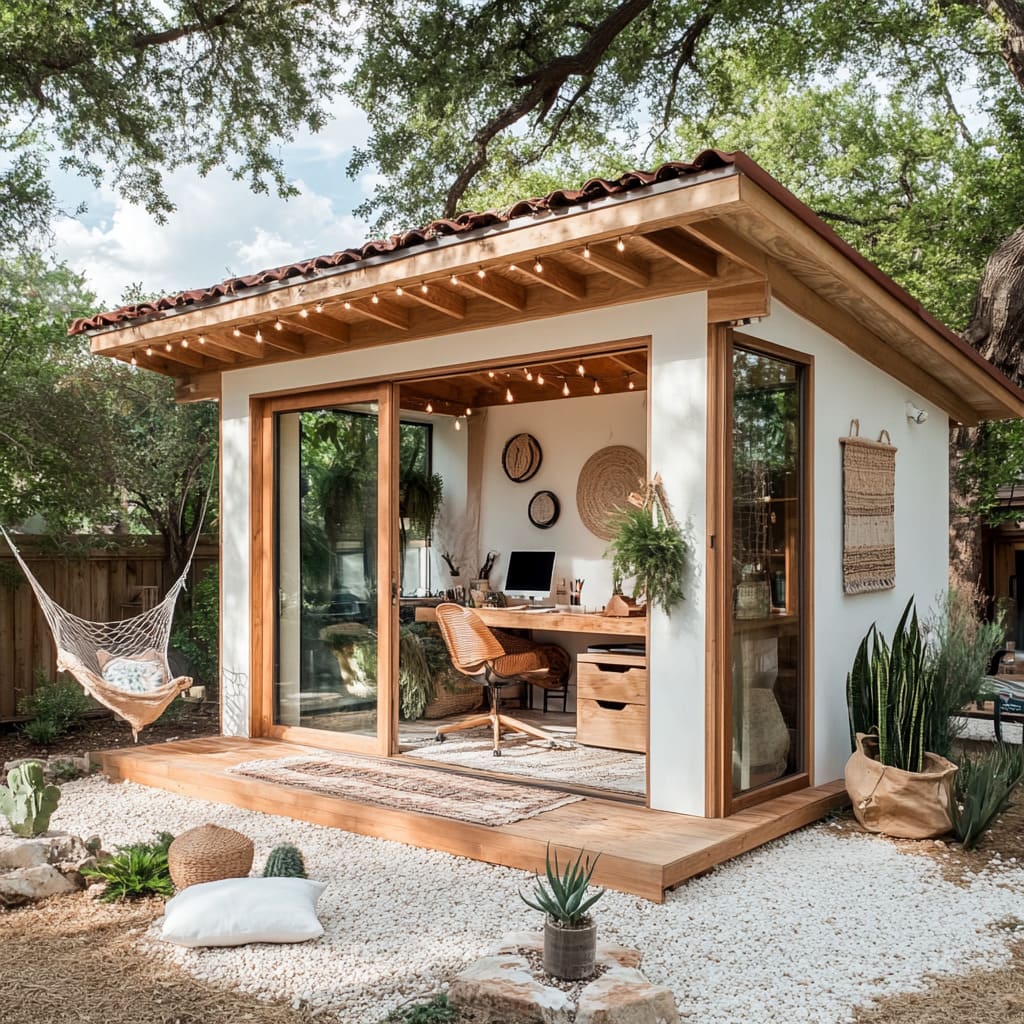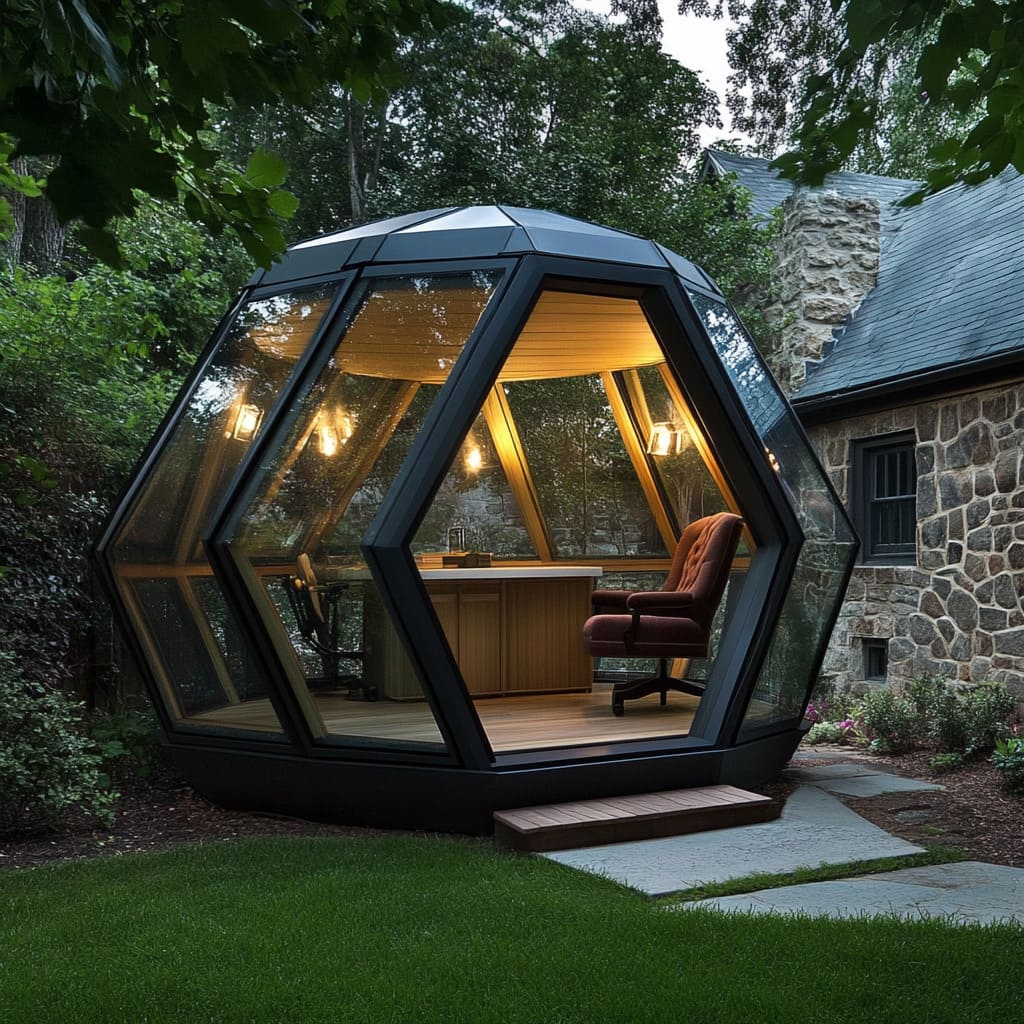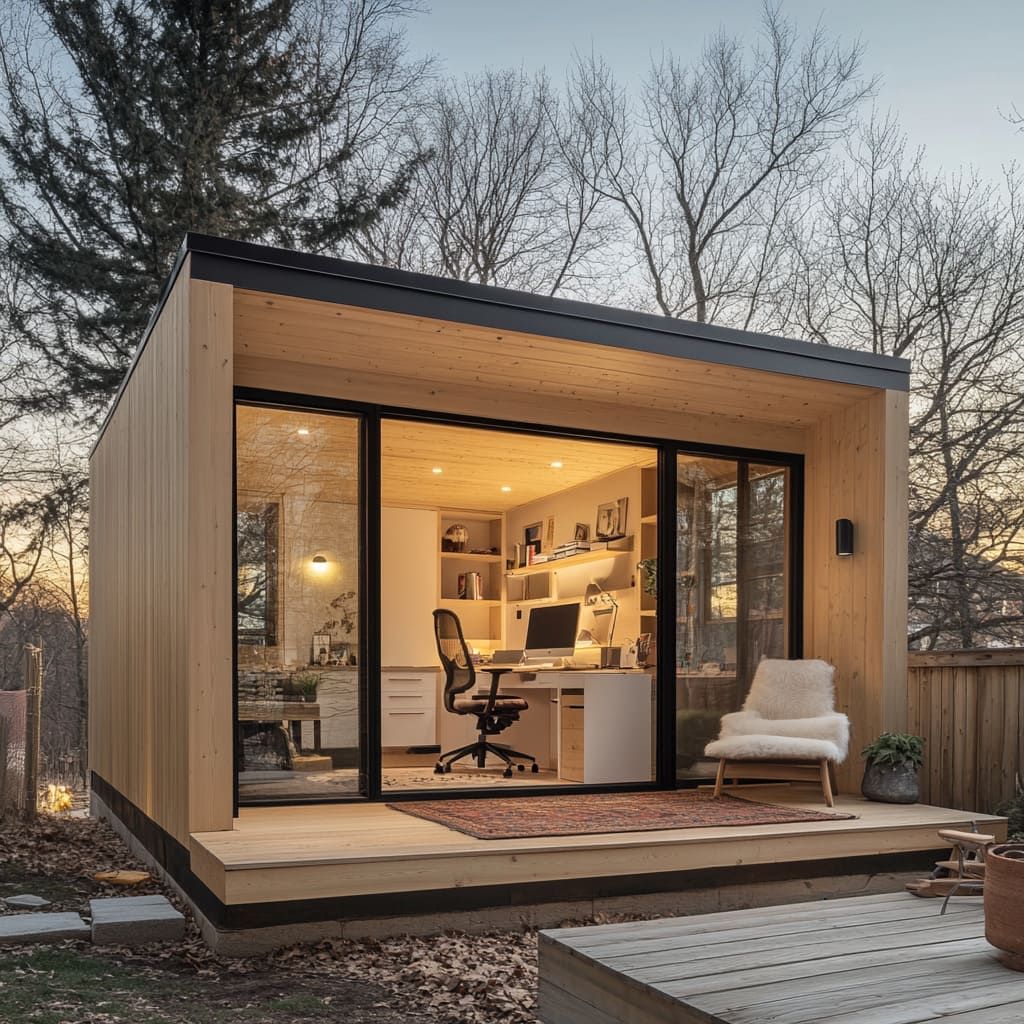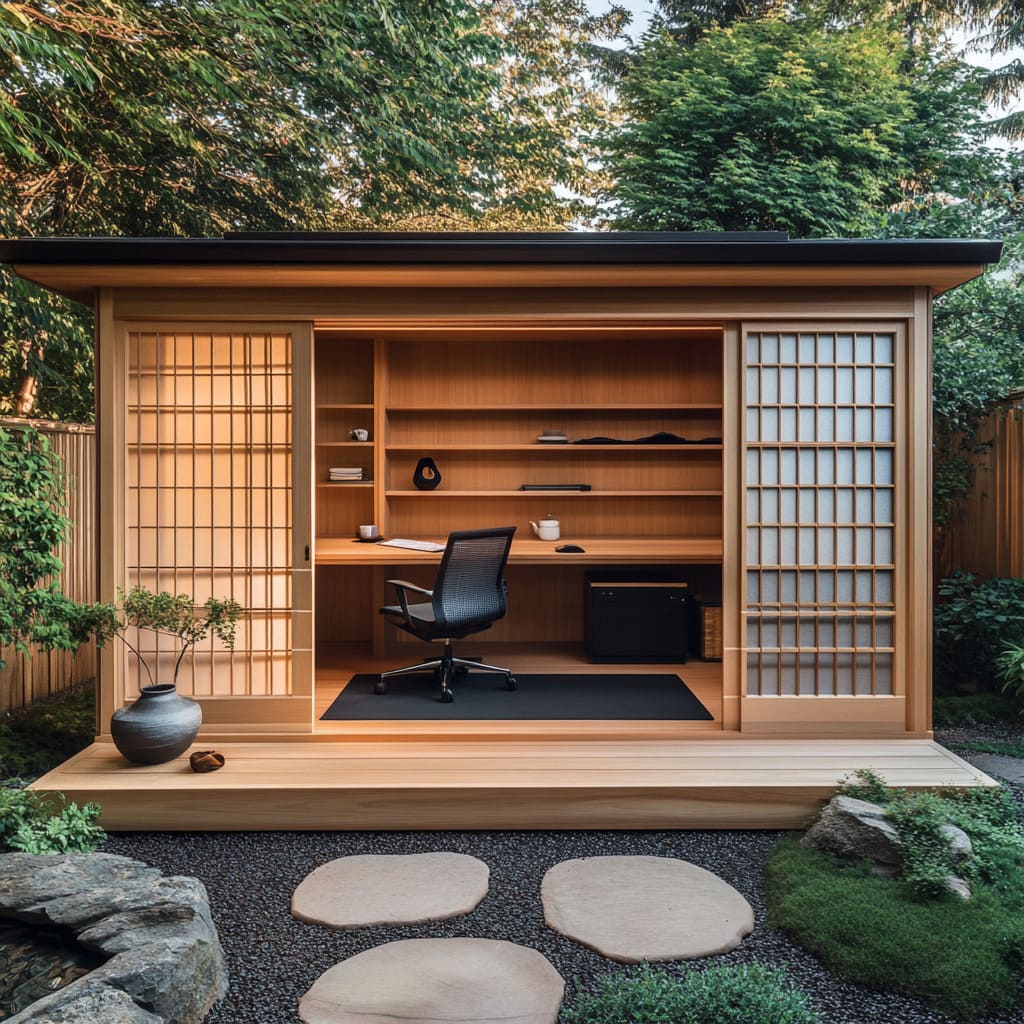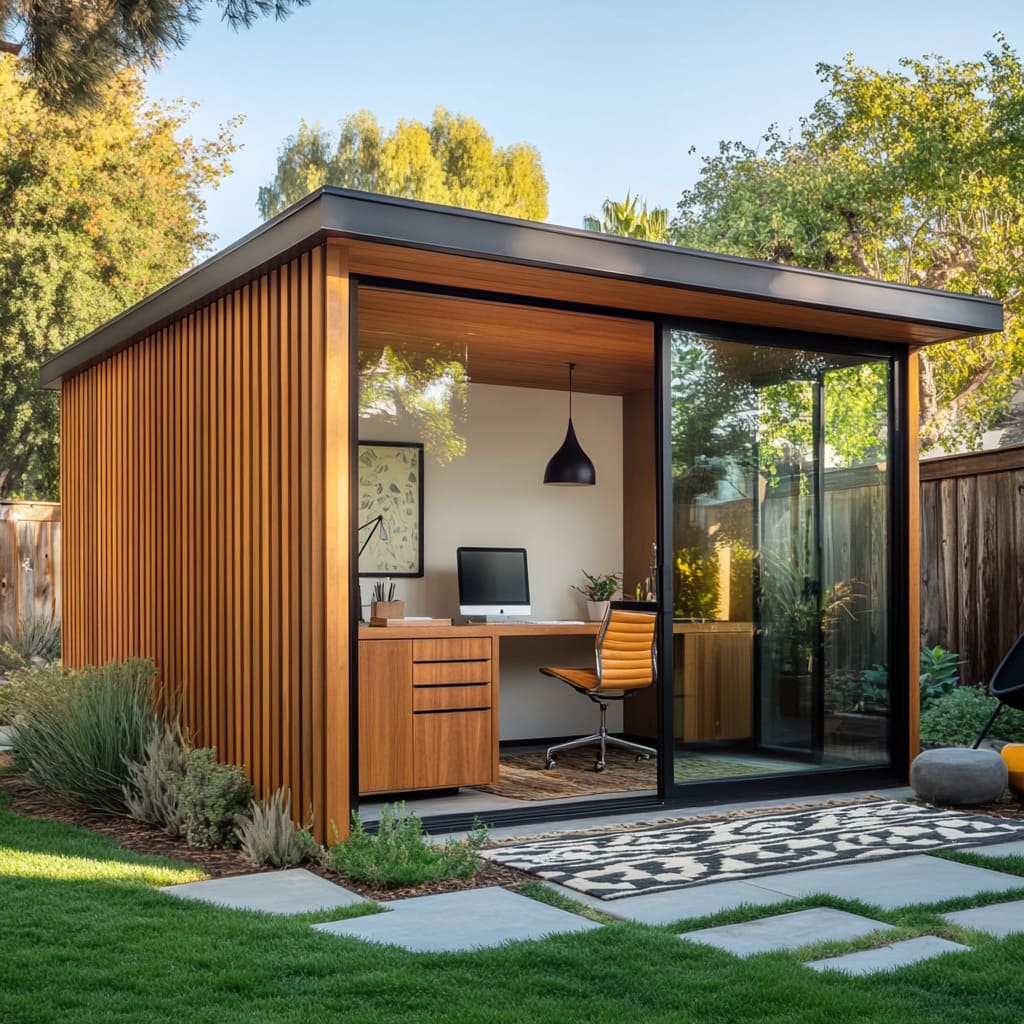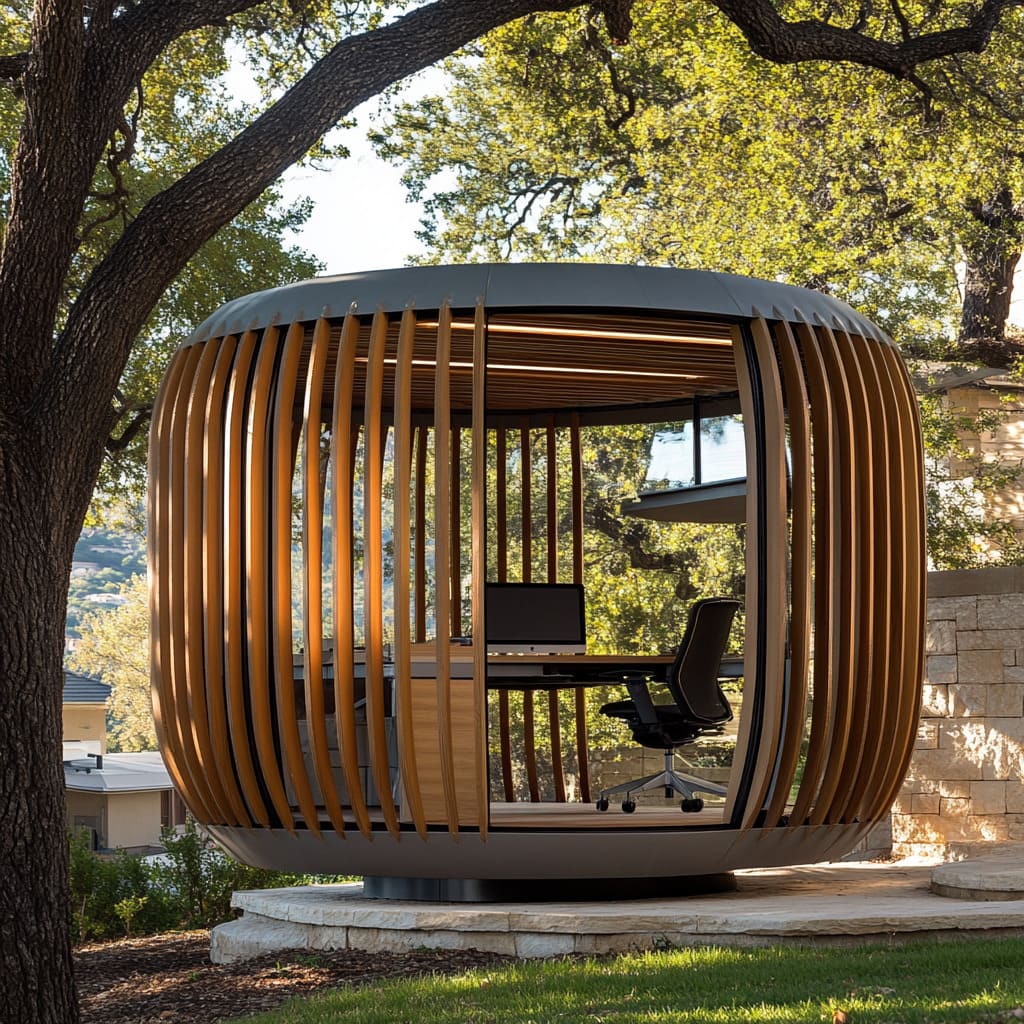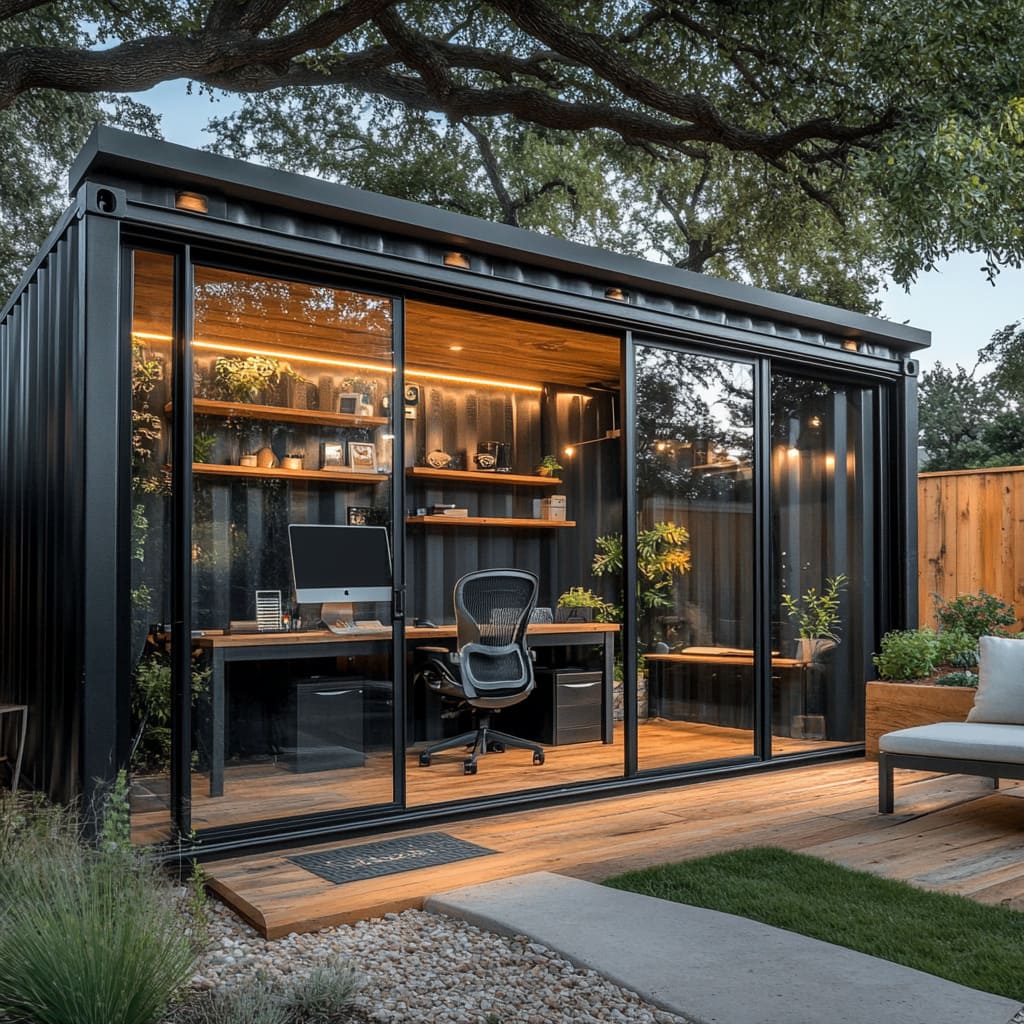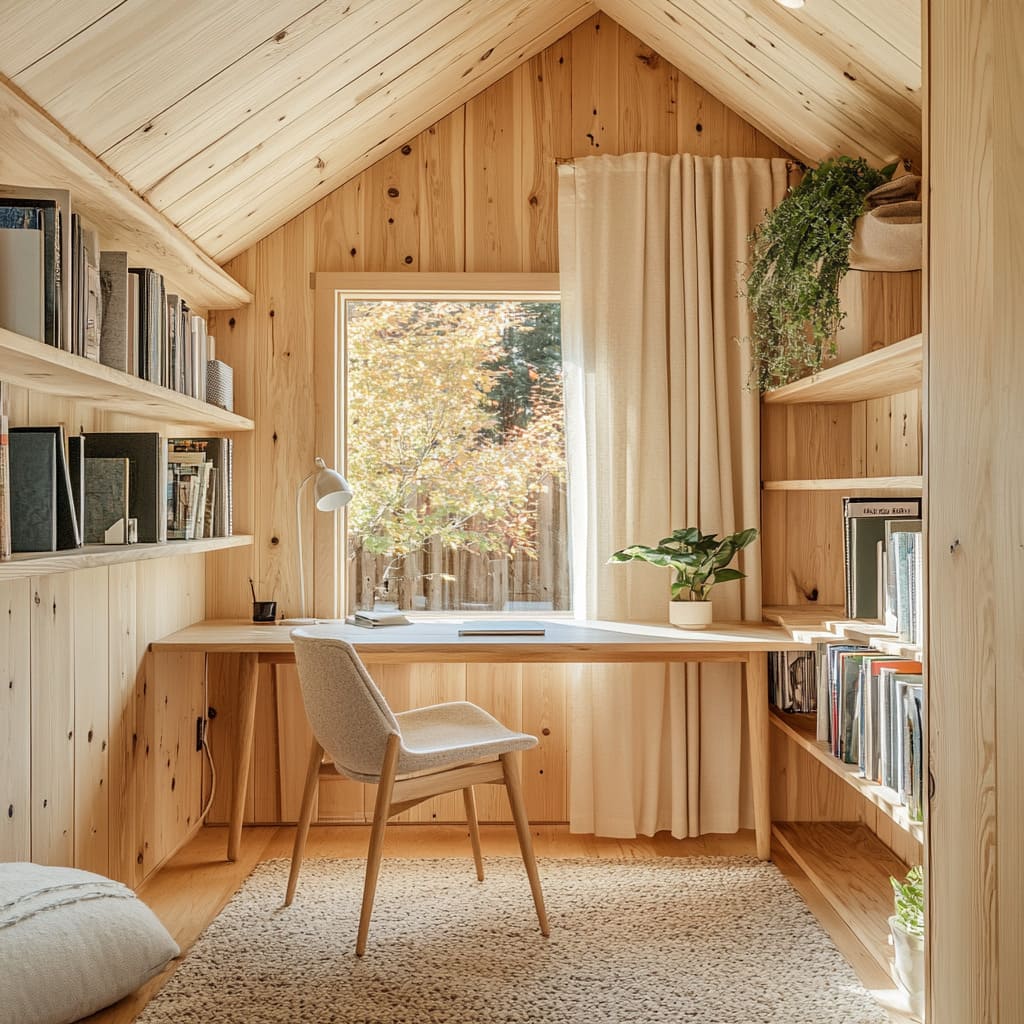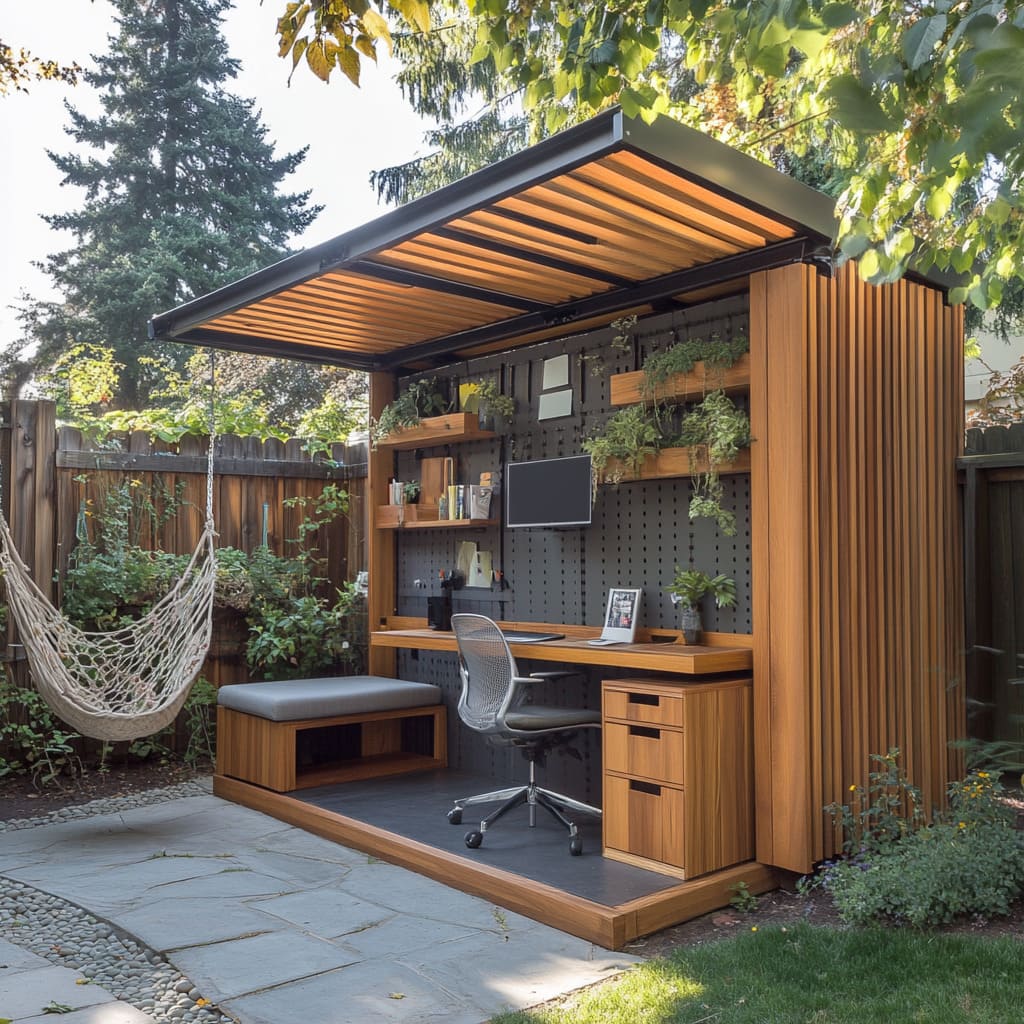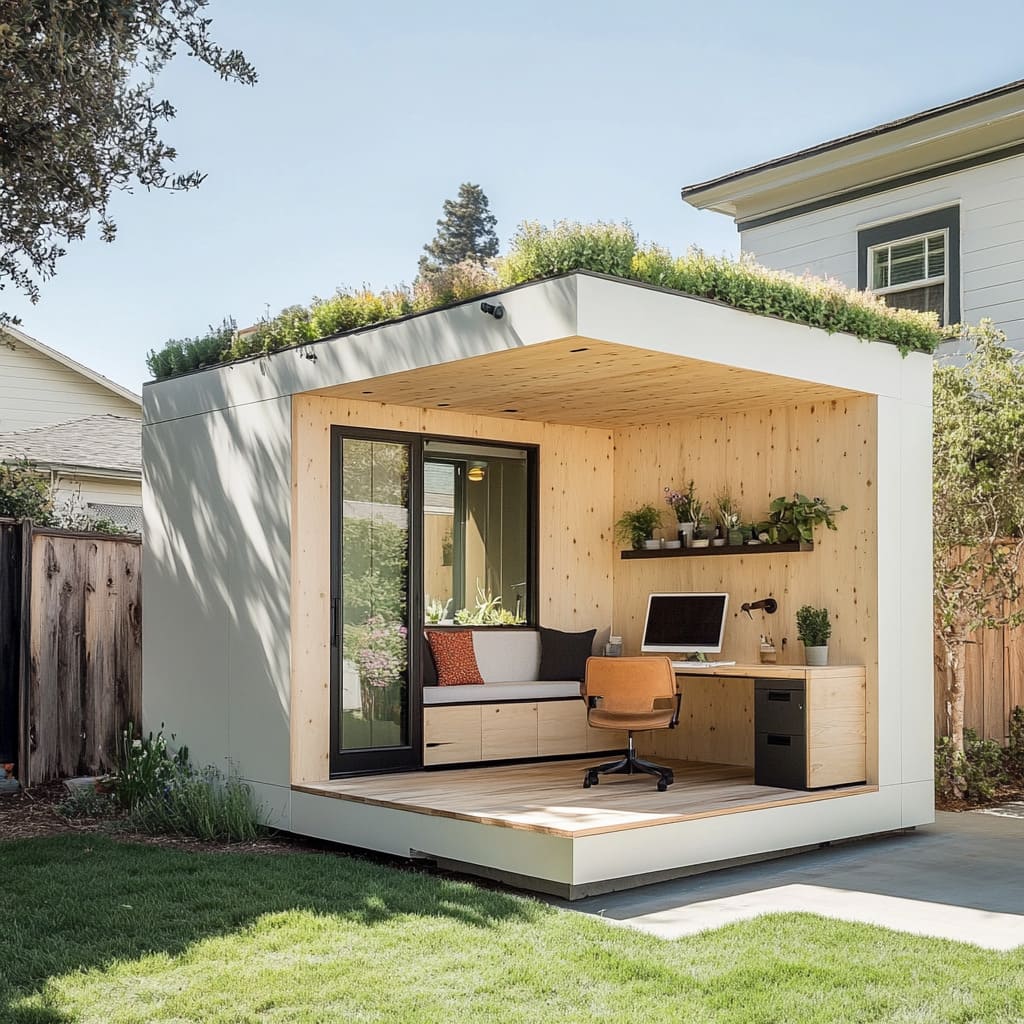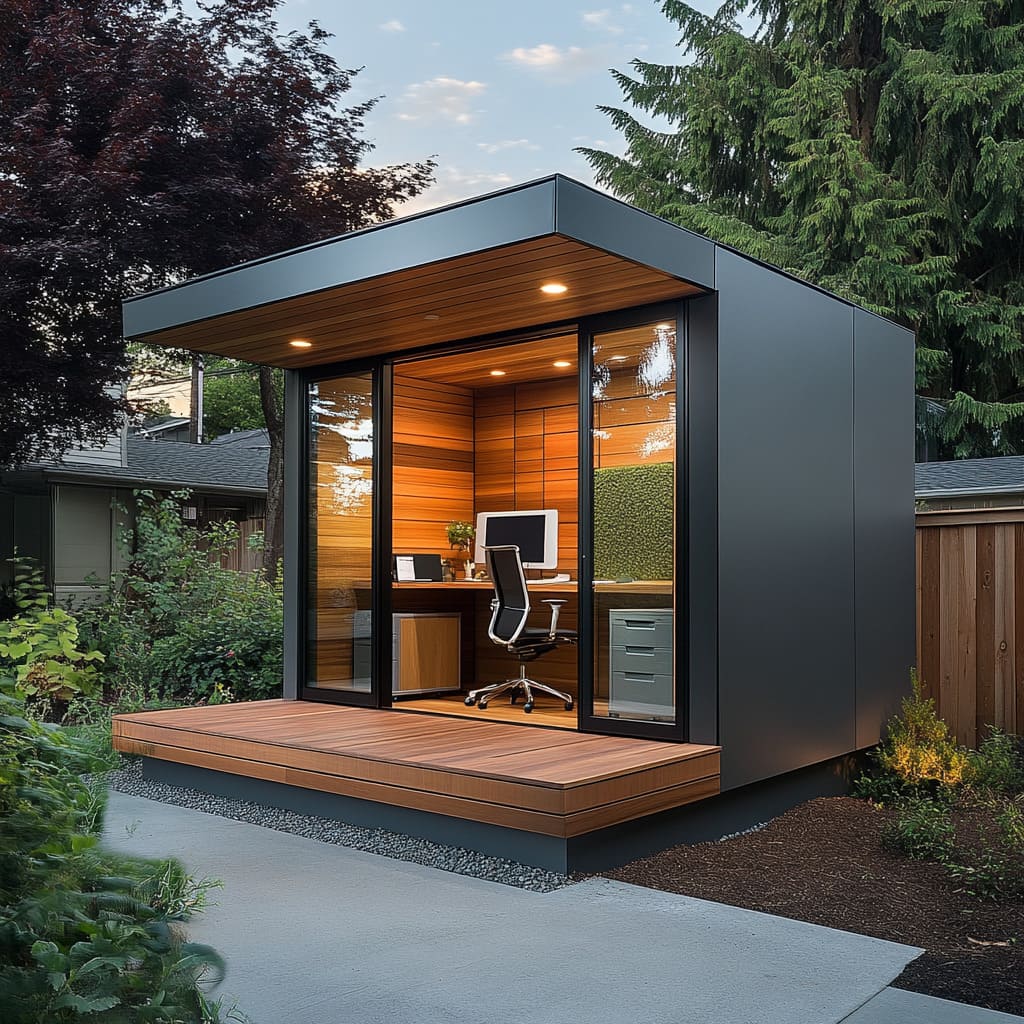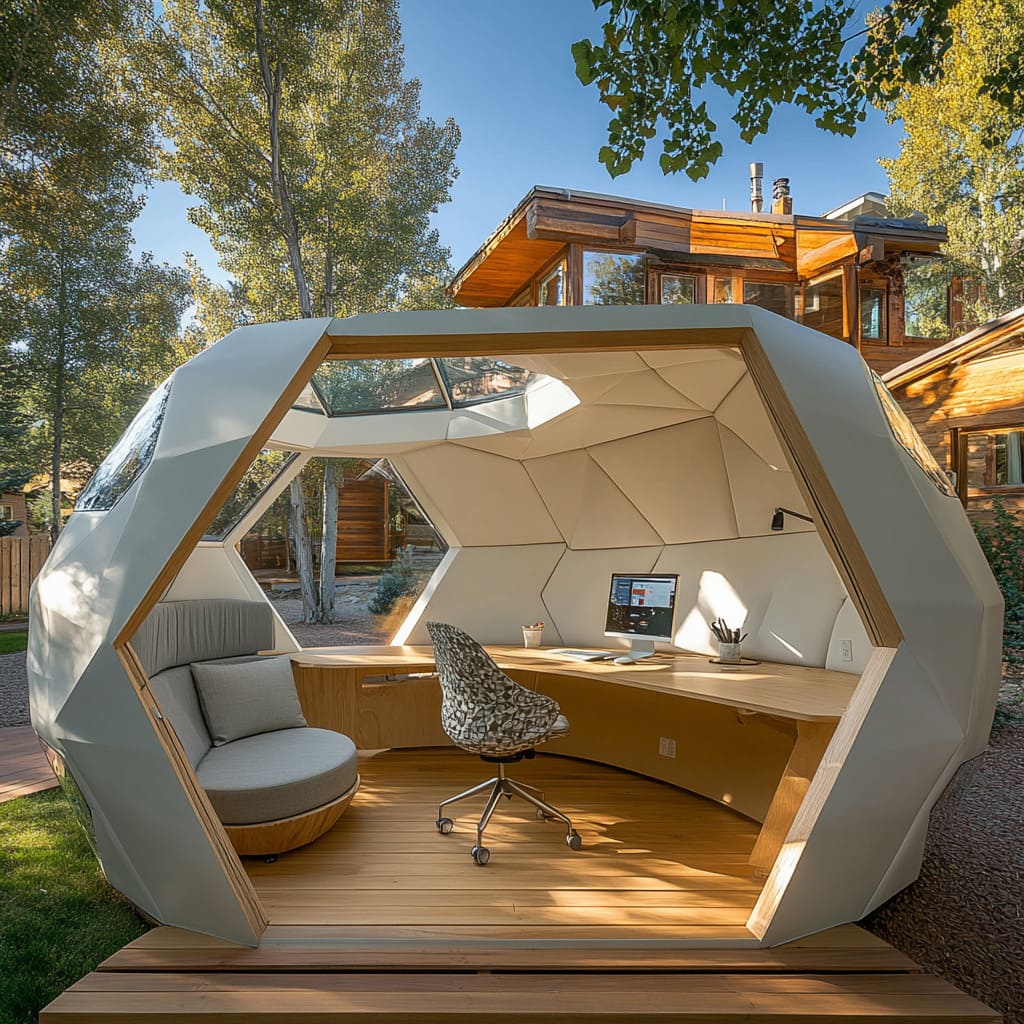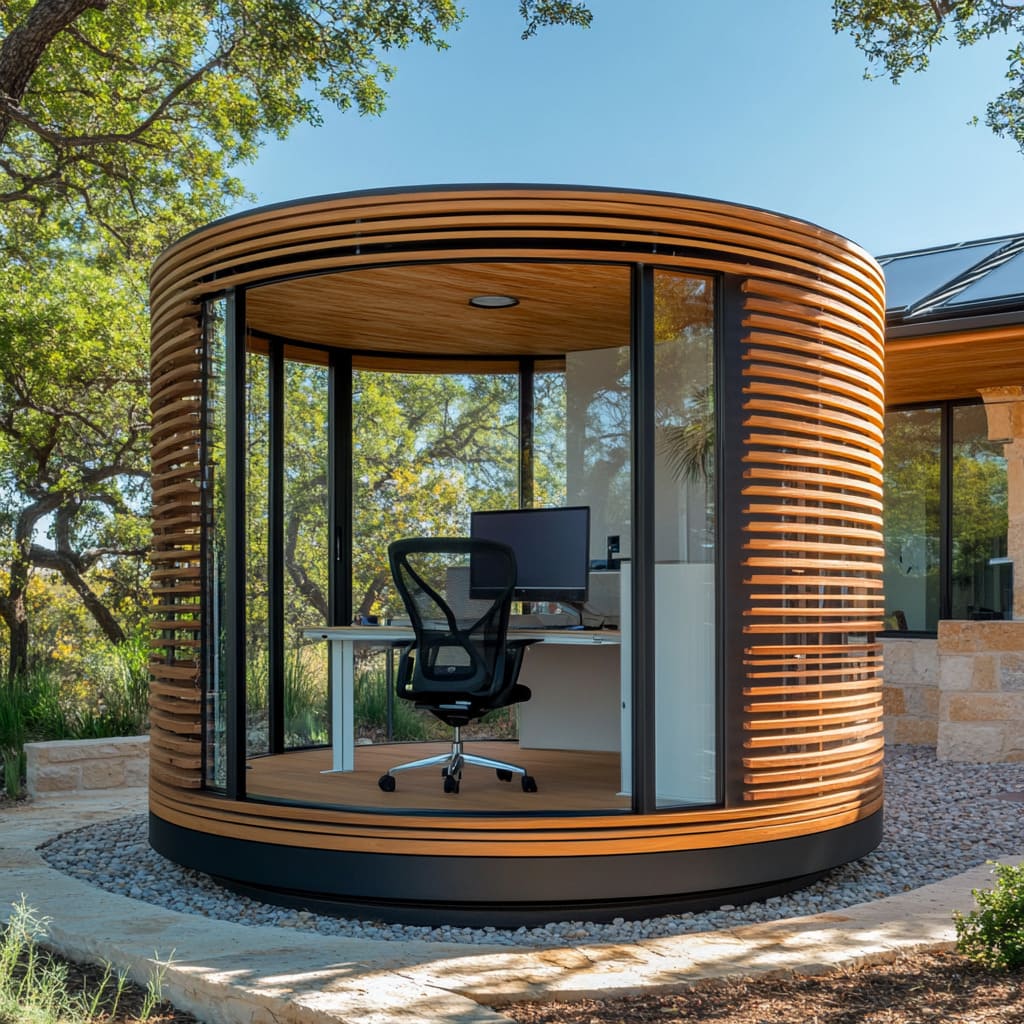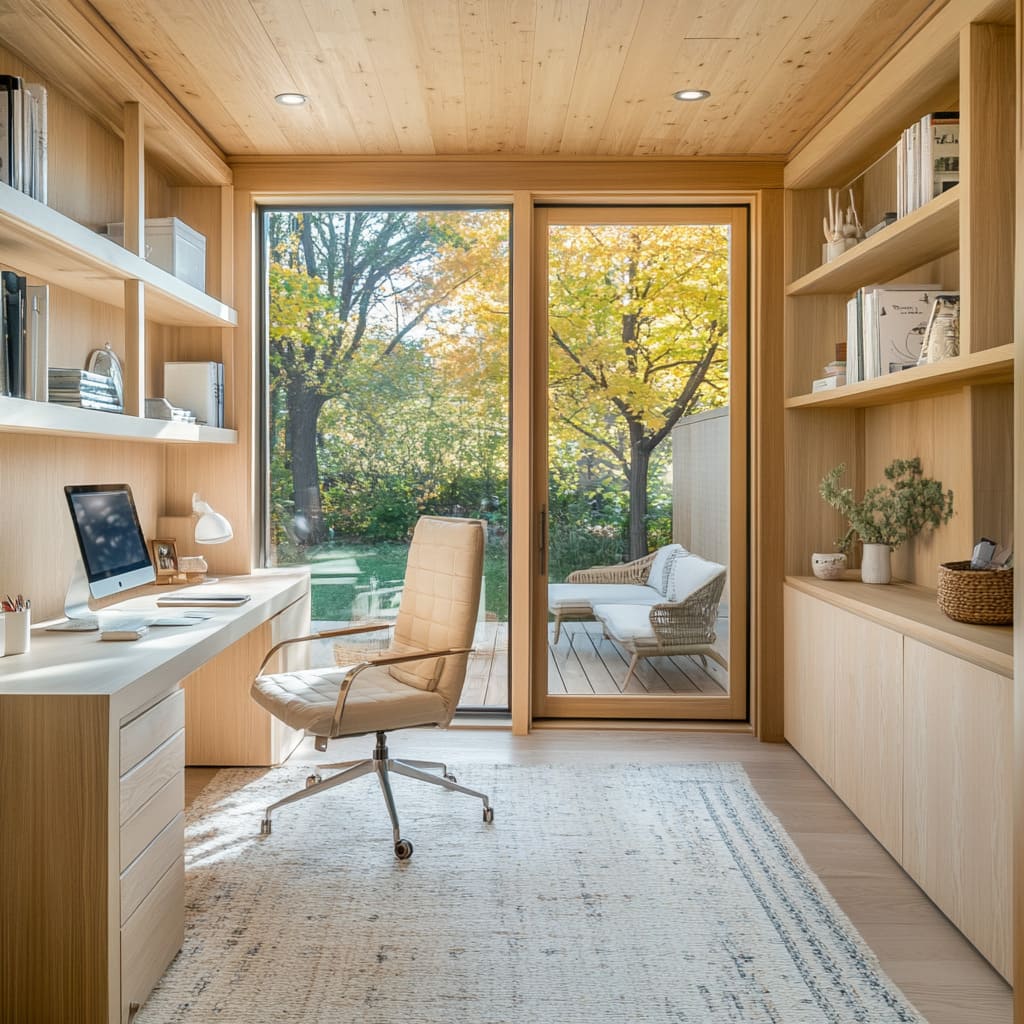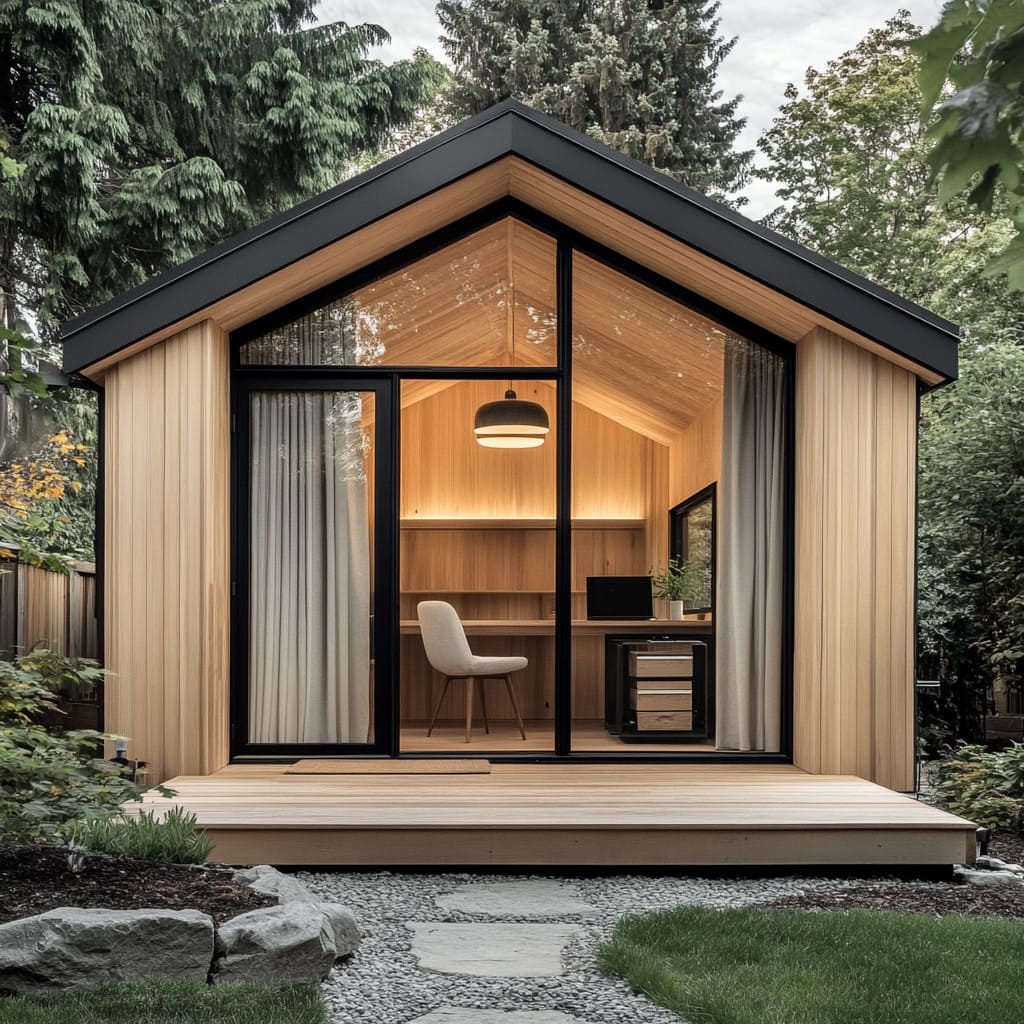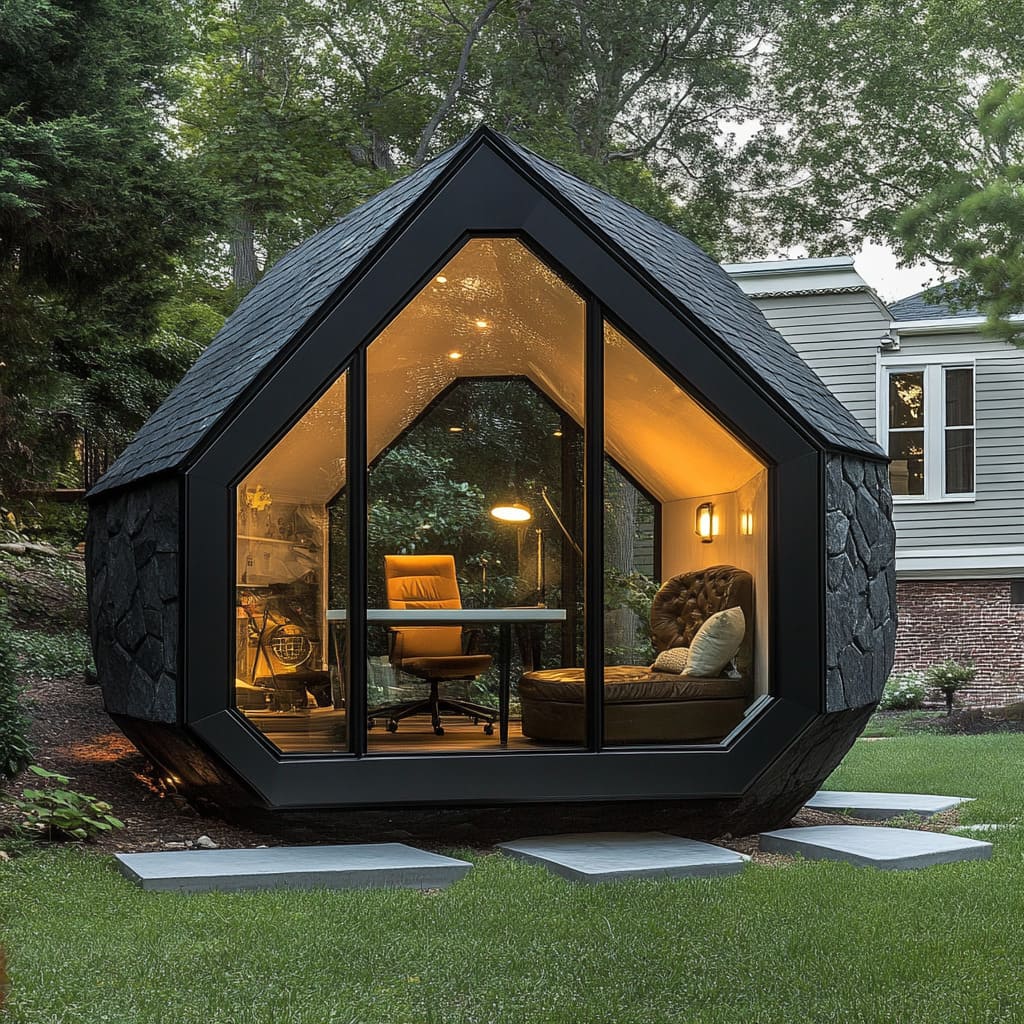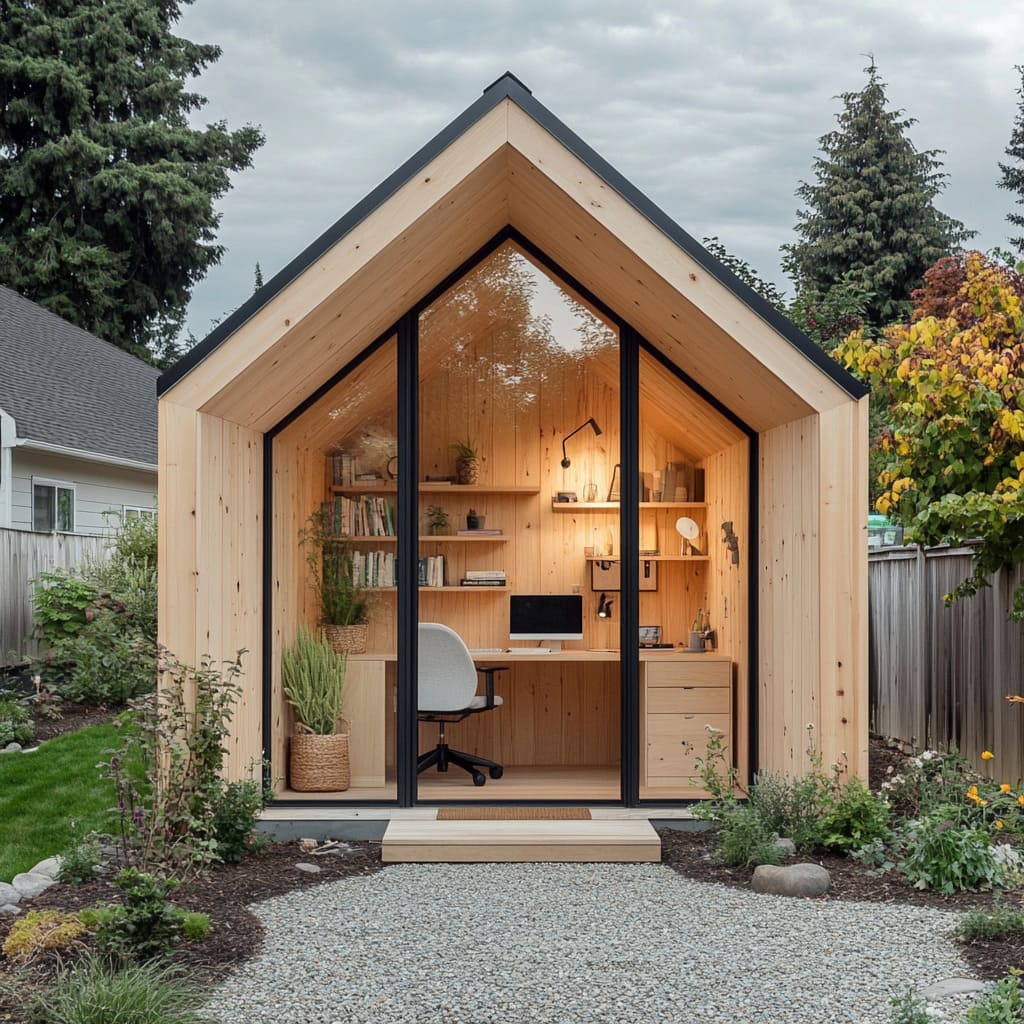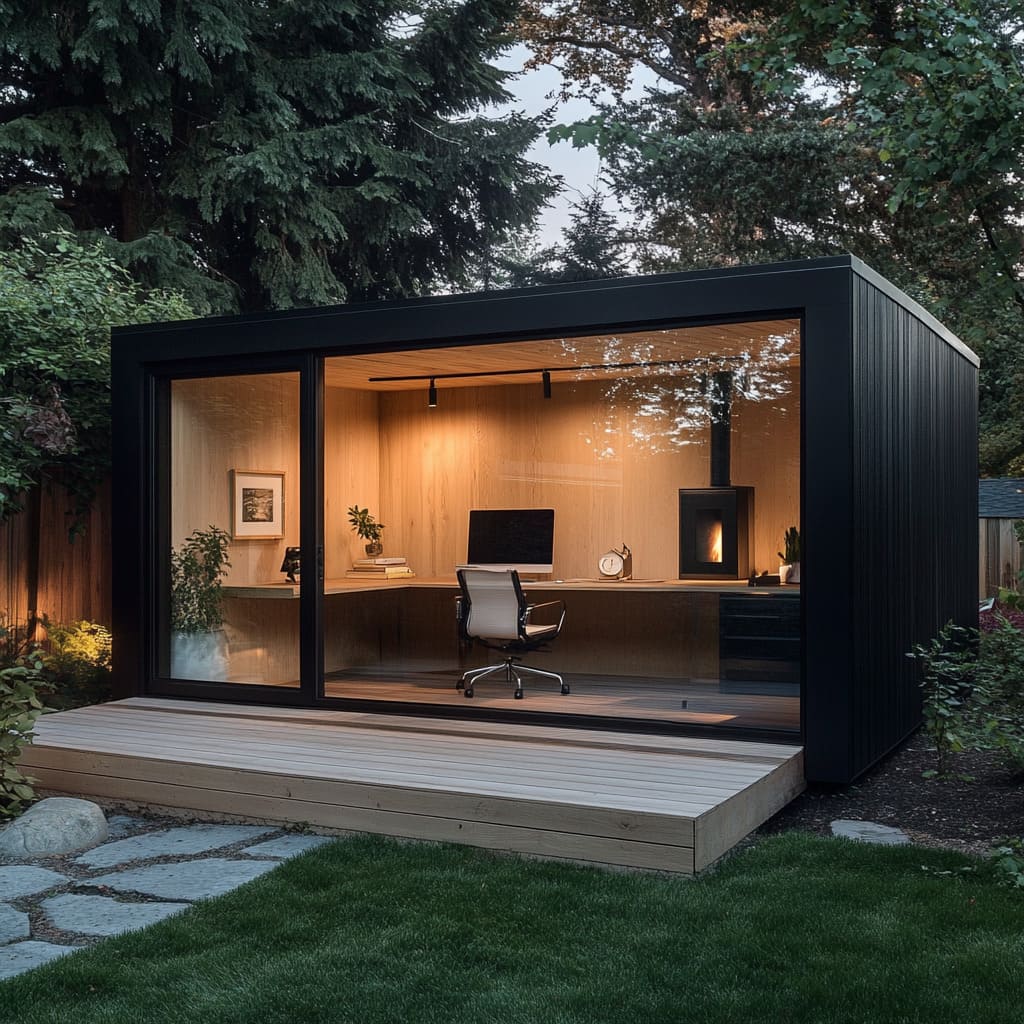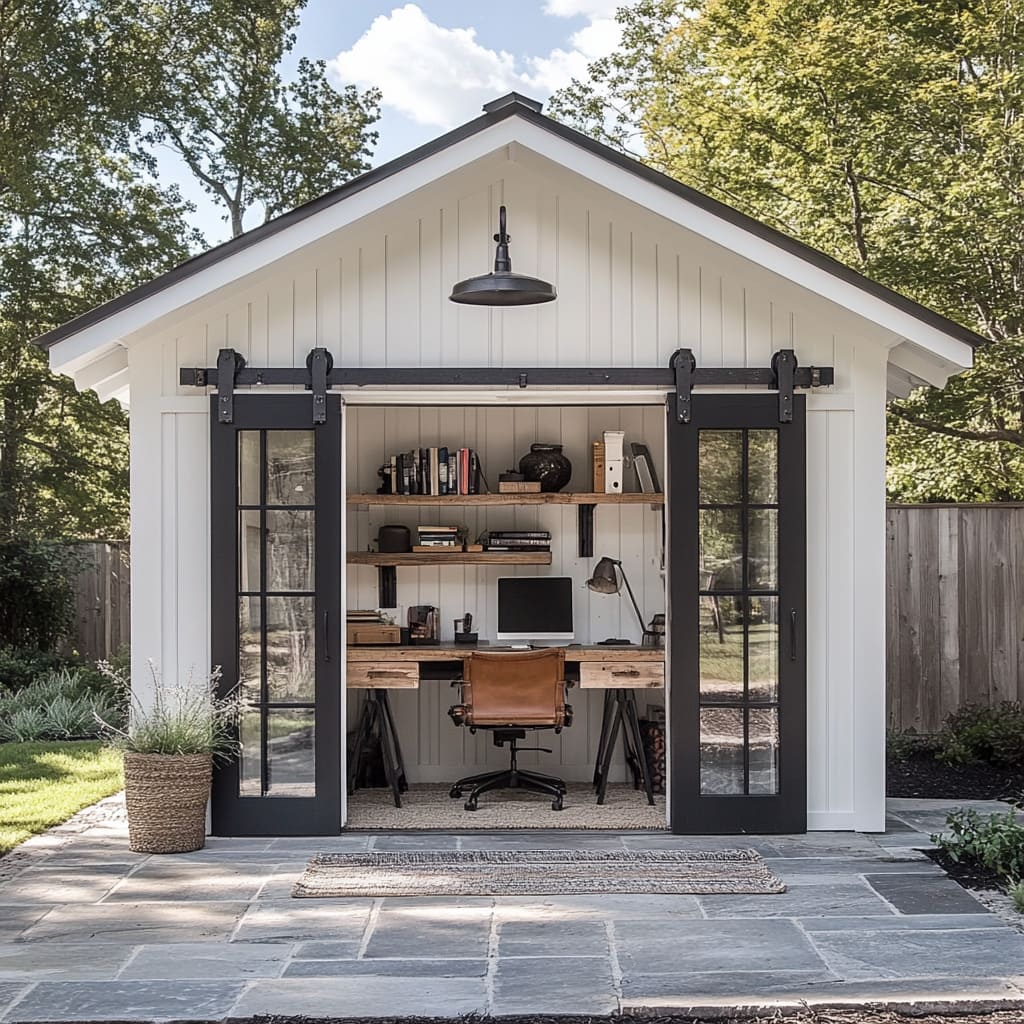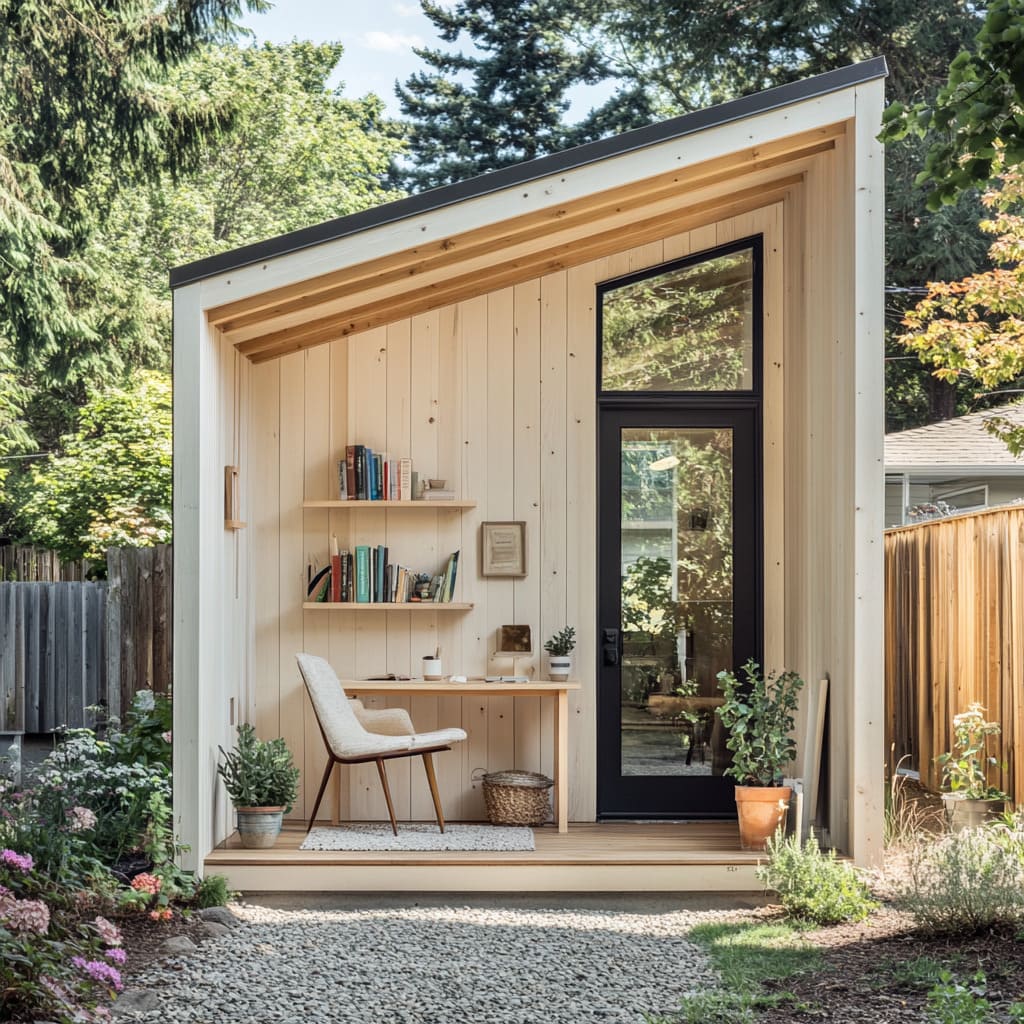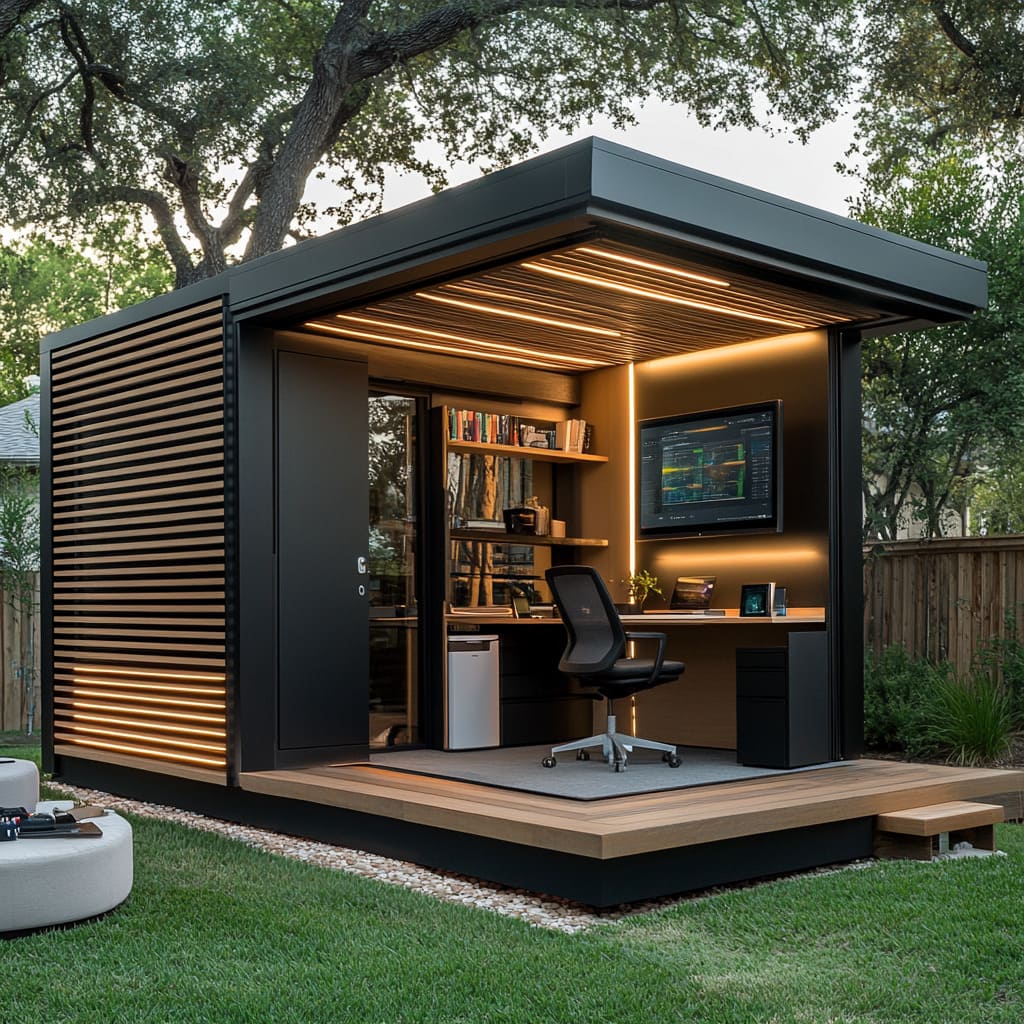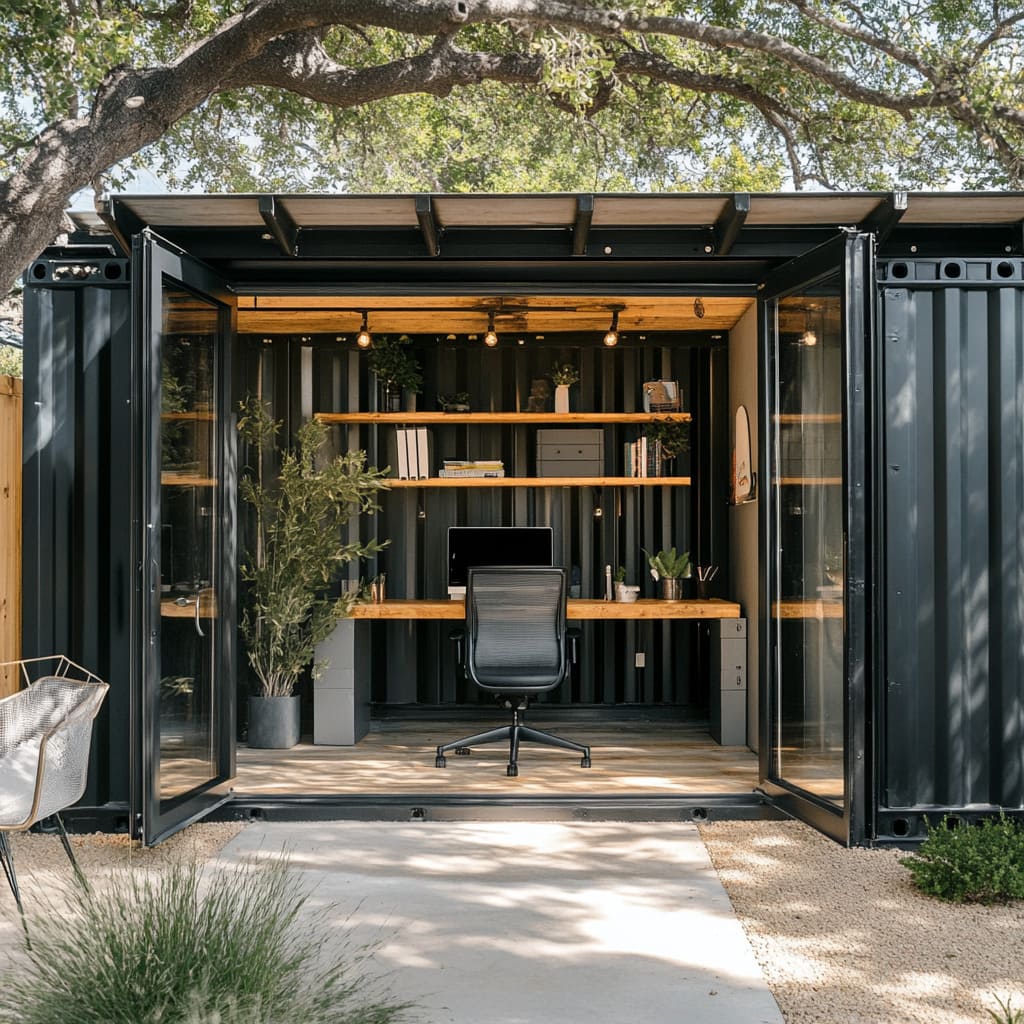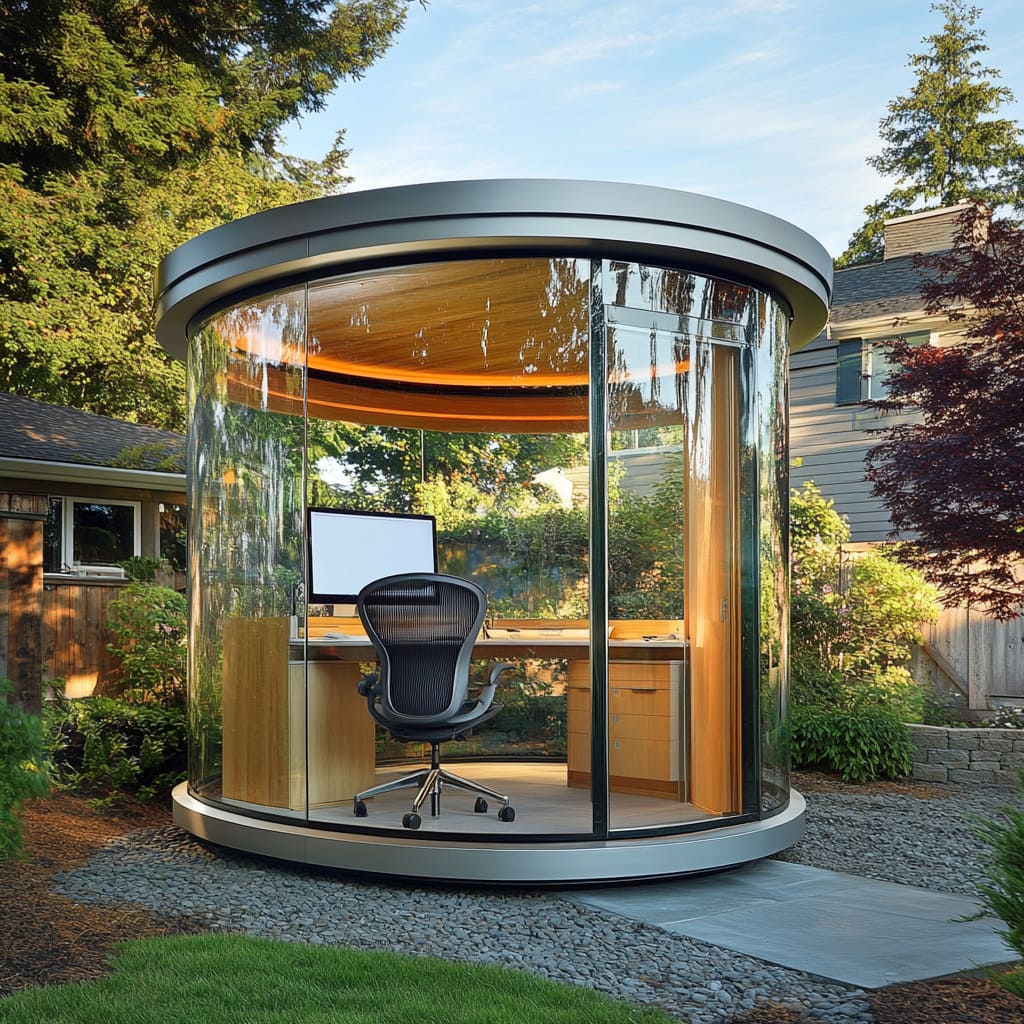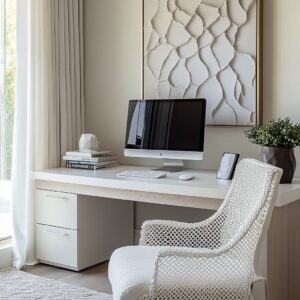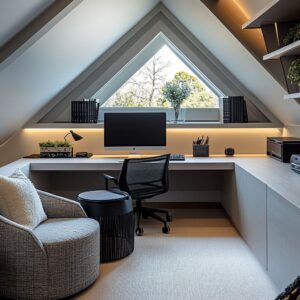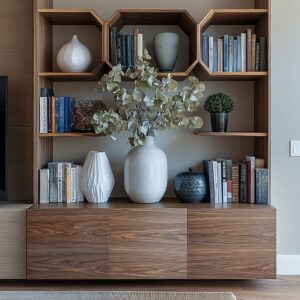Creating a backyard workspace is about more than adding four walls and a desk—it’s about designing a space that supports focus, comfort, and style while blending naturally into its surroundings. Whether you need a quiet retreat for deep work, a well-lit studio for creative projects, or a multipurpose setup for meetings and brainstorming, the right office shed ideas can make all the difference.
From slatted panels that filter natural light to carefully chosen rooflines that impact both ventilation and aesthetics, small details shape how an office shed feels and functions. The best designs don’t just provide a place to work—they enhance productivity by balancing comfort, efficiency, and a strong connection to the outdoors.
This guide explores standout office shed designs, breaking down what makes each one unique and how you can apply these concepts in your own backyard. Whether your style leans modern, Scandinavian, industrial, or something entirely personal, thoughtful planning will ensure that your shed becomes more than just a workspace—it will feel like a natural part of your home.
Using Vertical or Slatted Surfaces for Shade and Texture
When designing an office shed, it’s easy to focus on layout, furniture, and lighting while overlooking how exterior elements can shape the interior environment. One standout feature in many well-designed sheds is the use of vertical wooden slats or screened panels, which serve both a functional and aesthetic purpose.
These additions help regulate sunlight, maintain privacy, and create a visually engaging exterior.
Adding Texture and Depth with Slatted Woodwork
Vertical slats add a rich sense of depth to a garden shed office while allowing for light diffusion and airflow. Instead of a flat, unbroken facade, slatted surfaces introduce a rhythmic pattern that changes throughout the day as the sunlight shifts.
The gaps between the wood slats can be spaced evenly for a structured, modern look or varied for a more organic, layered effect. One of the key benefits of this design approach is that it keeps the interior bright without exposing it entirely to outside views.
When placed strategically, these wooden screens offer partial privacy, creating an environment that feels open but still secluded enough for focused work. If the workspace faces a busy street or a neighbor’s yard, the slats help soften the view while maintaining a strong connection to natural surroundings.
Controlling Temperature with Passive Shading
Direct sunlight can quickly turn a small workspace into an oven, making temperature control a major consideration. Slatted surfaces work as a passive cooling system, filtering sunlight before it reaches the glass and reducing heat buildup.
This effect is particularly useful for sheds with floor-to-ceiling windows or large sliding doors, as these openings can magnify heat gain during peak daylight hours. By adjusting the spacing of the slats, you can control how much sunlight enters the shed while allowing natural ventilation to keep the space comfortable.
This design trick is especially effective in warm climates, where air circulation plays a key role in maintaining a pleasant indoor environment without relying too heavily on mechanical cooling.
Applying This Design to Your Own Backyard Office Shed
If you’re considering adding vertical slats to your office shed, start by analyzing how sunlight moves across your yard throughout the day. Position the slats on the side that receives the strongest afternoon sun to reduce glare and heat.
If your workspace requires more privacy, opt for closer spacing between the slats to create a semi-solid screen. For long-term durability, choose wood types that naturally resist moisture and decay, such as cedar, teak, or thermally treated pine.
If you prefer a more industrial look, metal slats with a powder-coated finish can offer the same benefits with added durability. Slatted designs aren’t just about function—they add a refined touch to a simple shed structure, making it feel more intentional and visually connected to the surrounding landscape.
Whether you’re aiming for a Scandinavian-inspired retreat, a mid-century modern workspace, or a contemporary office shed, incorporating vertical wood elements can completely transform the feel of your backyard workspace.
Integrating Large Glass Openings for Light While Maintaining Privacy
Natural light can completely change the way an office shed design feels, making a small space look more open and inviting. Floor-to-ceiling windows, glass walls, and large sliding doors bring in daylight, reducing the need for artificial lighting and creating a seamless connection with the outdoors.
However, maximizing light comes with its own challenges—too much exposure can affect privacy, and extensive glass panels can lead to overheating if not managed properly.
Balancing Natural Light with Privacy
A workspace with expansive glass walls offers a sense of openness, but it can also feel exposed if the shed is positioned near a neighbor’s fence or a busy area. To maintain privacy without sacrificing daylight, consider a mix of transparent and frosted glass panels.
Placing frosted or textured glass on the lower sections can block direct views while allowing natural light to filter through. Another option is tinted glass, which reduces glare while keeping the interior less visible from the outside.
For those who prefer flexibility, installing sheer curtains or roller blinds gives control over how much visibility is allowed at different times of the day. In some modern designs, vertical wooden slats or perforated metal screens are used in combination with glass, softening the view while maintaining an airy feel.
Managing Heat and Thermal Performance
A shed with large glass surfaces can quickly become uncomfortably warm, especially in sun-drenched locations. Without proper shading, the greenhouse effect can trap heat inside, making the space difficult to use during peak hours.
To counter this, incorporating roof overhangs, awnings, or pergolas can reduce direct sun exposure while still allowing plenty of indirect light. Another effective approach is using low-emissivity (Low-E) glass, which helps regulate indoor temperatures by reflecting heat in the summer and retaining warmth in colder months.
For areas with strong afternoon sun, motorized shades or external louvers can add another layer of protection, adjusting as needed throughout the day.
How to Apply This in Your Own Backyard
Before finalizing your shed’s design, take time to study how sunlight moves across your yard. Position glass openings to capture morning light while avoiding excessive afternoon heat.
If privacy is a concern, plan for a mix of clear and frosted sections, or introduce natural barriers like shrubs and trees to filter views. By balancing light, privacy, and thermal comfort, a well-designed glass-heavy shed can feel bright and connected to nature without the drawbacks of excessive exposure.
Whether your goal is a modern workspace, a Scandinavian-style retreat, or a compact creative studio, thoughtful placement of glass elements will make all the difference in how the space feels throughout the day.
Blending Indoor Elements with the Exterior
A well-designed backyard office should feel like a natural extension of the outdoor space rather than a separate, standalone structure. The best designs create a smooth transition between the shed and the surrounding yard, making the workspace feel open and inviting.
Thoughtful choices in flooring, materials, and layout can help bridge the gap between indoor and outdoor elements, creating a seamless connection that enhances both function and aesthetics.
Extending the Floor for a Seamless Transition
One of the simplest ways to merge indoor and outdoor spaces is by aligning the shed’s floor with an adjacent deck or patio. When the flooring inside and outside sits at the same height, it removes the visual and physical barrier of a step, making the shed feel larger and more accessible.
This approach is particularly useful for small office sheds, as it extends the usable space beyond the walls and encourages movement between indoor and outdoor areas. A deck that matches the shed’s flooring material can also create a sense of flow.
Whether you opt for wood, composite decking, or concrete pavers, keeping the materials consistent will make the transition between the two areas feel effortless. In some designs, large sliding or folding glass doors further enhance this effect, making it possible to open up the office completely to the surrounding environment.
Material and Color Consistency for a Unified Look
Using similar materials and colors inside and outside the shed helps tie the structure to its surroundings. For example, if the shed’s exterior is clad in warm wood, incorporating that same wood into the interior—whether on the ceiling, shelving, or accent walls—creates a cohesive design.
Similarly, matching the window or door trim with outdoor elements like fencing, pergolas, or garden furniture can reinforce a unified aesthetic. Even small details, like carrying over the same shade of stain or paint from the shed’s exterior to an outdoor deck, make a noticeable difference.
These subtle connections make the structure feel intentional rather than an afterthought, giving the workspace a polished and integrated look.
How to Apply This in Your Own Backyard
For those exploring backyard office ideas, the key is to plan the surrounding space alongside the shed itself. If you’re adding a deck, choose a wood species or composite material that complements the shed’s exterior finish.
If you prefer a more natural look, a stepping-stone path leading to the entrance can enhance the transition while maintaining a relaxed, organic feel. Another way to reinforce the connection between indoor and outdoor areas is through landscaping.
Low-maintenance plants placed near the entrance, a gravel border around the shed, or a seating area just outside the door can soften the edges of the structure and make it feel more like a natural part of the yard. By focusing on flooring continuity, material harmony, and thoughtful landscaping, your office shed can become more than just a workspace—it can feel like an organic extension of the backyard, blending comfort, function, and style into one cohesive design.
Clever Storage and Built-In Furniture
A well-organized office shed isn’t just about fitting in a desk and a chair—it’s about making the most of every square inch. Space-saving solutions can turn a compact workspace into a highly functional and clutter-free environment, especially in sheds where every detail counts.
The smartest designs integrate hidden storage and built-in furniture, allowing for a streamlined look without sacrificing practicality.
Hidden Storage in Unexpected Places
One of the biggest challenges in smaller workspaces is maintaining a clean and open feel while keeping essential supplies within reach. Many well-designed sheds hide storage in places that aren’t immediately obvious.
Built-in benches with concealed compartments offer extra space for books, paperwork, or even tech accessories without adding bulk. Another clever approach is floating desks and shelving, which create storage underneath without visually overwhelming the room.
Pegboard walls offer a customizable way to keep office supplies or tools organized, blending functionality with design. In some sheds, overhead cabinets or recessed shelving in the walls maximize vertical space, ensuring that storage doesn’t take away from the working area.
Custom Desk Shapes for Optimized Layouts
In sheds that break away from the traditional rectangular layout, custom-built desks can be designed to follow the shape of the space. Curved desks work well in rounded or geodesic office sheds, making full use of corners while keeping movement fluid.
Angled workstations are a great solution for sheds with sloped walls, ensuring that no space is wasted. The key is to think beyond standard office furniture.
A desk that integrates drawers, shelves, or cable management keeps everything organized without the need for additional storage units. When combined with a built-in seating area or an adjustable work surface, it creates a multi-functional workspace suited to different tasks throughout the day.
How to Apply This in Your Own Backyard
For those looking into home office shed ideas, planning storage solutions before construction can make a huge difference. Before finalizing the design, list out what you’ll need to store—office supplies, tech gadgets, books, or even extra seating—and integrate these requirements into the shed’s layout.
A built-in desk with shelving above keeps everything within reach while maintaining a minimalist aesthetic. If space is tight, a fold-down desk or a wall-mounted workstation can keep the floor area open when not in use.
Storage ottomans, pull-out compartments, and modular shelving can further enhance functionality without adding unnecessary clutter. By thinking strategically about storage and built-in furniture, a backyard shed can become much more than a basic workspace.
With the right design, it can function as a well-organized, comfortable home office that supports productivity while maintaining a clean and stylish look.
Variations in Roof Forms Affect Spatial Experience
The shape of a roof does more than define the exterior look of an office shed—it directly influences the interior atmosphere, comfort, and functionality of the space. A well-chosen roof design can create a sense of openness, improve ventilation, and even provide opportunities for additional features like skylights or solar panels.
Whether you prefer a traditional pitched look or a sleek, modern structure, the right choice can make a significant difference in how your workspace feels and functions.
Gabled and A-Frame Roofs for Height and Airiness
For those who want a workspace that feels spacious and open, a gabled or A-frame roof is an ideal solution. The steep angles naturally create extra headroom, making even a compact shed feel less restrictive.
This added height is particularly beneficial for ventilation, allowing warm air to rise and escape more efficiently, which helps regulate indoor temperatures. A-frame designs are often associated with Scandinavian and rustic-inspired office sheds, where a cozy yet airy interior is the goal.
Exposed rafters can further enhance the feeling of depth, adding architectural character while keeping the space from feeling too boxy. The dramatic roofline also provides a strong visual presence, making it an attractive addition to any backyard.
Flat and Subtly Sloped Roofs for a Modern Look
For a minimalist and contemporary aesthetic, a flat or slightly sloped roof is a popular choice. This style keeps the overall profile low, allowing the shed to blend more naturally into the surrounding landscape.
A flat roof is also a practical option for those interested in green roofing (where plants or moss are integrated into the roof surface) or installing solar panels to power the workspace sustainably. However, completely flat designs can lead to water pooling, which is why a slight incline is often recommended.
Even a minimal slope ensures proper drainage, preventing long-term issues related to moisture buildup. The clean lines of a flat roof also make it a great match for modern garden offices, particularly those with large glass openings that emphasize indoor-outdoor flow.
How to Apply This in Your Own Backyard
Choosing a roof form should take both aesthetic preference and practical needs into account. If you want a workspace with a light, airy feel, a gabled or A-frame roof can visually expand the space while improving air circulation.
On the other hand, if you prefer a sleek, understated design, a flat or gently sloped roof will offer a modern look with the flexibility for rooftop features. For those exploring shed home office ideas, consider how the roof will complement existing structures in your yard.
Matching the slope or material to your home’s architecture can create a cohesive look, while contrasting designs can make the shed stand out as a unique feature. Regardless of style, integrating functional elements like overhangs for shade, skylights for natural illumination, or insulation for temperature control will ensure your office remains comfortable and efficient throughout the seasons.
Detailing That Elevates the Interior Ambiance
A well-designed office shed isn’t just about function—it’s about creating a space that feels inviting and comfortable while supporting productivity. Small details like lighting placement, textures, and decorative accents can make a significant impact on the overall atmosphere.
Whether the goal is a minimalist modern retreat or a cozy home office, thoughtful interior elements can transform the shed into a workspace that feels as good as it looks.
Subtle Lighting for a Softer Atmosphere
Lighting plays a crucial role in setting the right mood, especially in a compact workspace. Concealed lighting strips under shelves, along ceiling beams, or behind furniture create an ambient glow without adding clutter.
This kind of indirect lighting is softer on the eyes, reduces glare on screens, and makes the space feel warm and inviting—ideal for working long hours without fatigue. Adjustable lighting with dimmable features and color temperature control allows for flexibility.
Warmer tones can make the space feel cozy during early mornings or late-night work sessions, while cooler white light enhances focus during the day. If the shed has exposed beams or floating shelves, integrated LED strips can highlight these architectural features, adding subtle depth to the interior.
Comfortable Accents That Make a Difference
Even the most stylish office shed can feel unwelcoming if it lacks warmth. Soft textures and natural elements can shift the space from purely functional to genuinely inviting.
A small area rug under the desk or a plush seat cushion can break up hard surfaces and add a layer of comfort. Adding a lounge chair, bench, or reading nook can turn the office into more than just a work area—it becomes a retreat for brainstorming, casual reading, or taking a break without leaving the space.
If square footage is limited, even a simple built-in bench along one wall can provide an extra seating option without taking up too much room. Potted greenery can also work wonders, softening the workspace while improving air quality.
A few well-placed plants on floating shelves, a hanging planter, or even a larger potted tree near the entrance can bring in natural energy, making the space feel more dynamic and lived-in.
How to Apply This in Your Own Backyard
For those exploring shed office interior ideas, start by layering different types of lighting—task lighting for the desk, ambient lighting for warmth, and accent lighting for added character. Opt for adjustable fixtures to switch between work mode and relaxation effortlessly.
Introduce at least one soft furnishing to contrast with wood, metal, or glass surfaces. A rug, a throw blanket, or an upholstered chair can create a more inviting atmosphere without overwhelming the space.
If minimalism is the goal, even a well-placed floor cushion can serve as a functional yet stylish addition. By combining practical lighting, thoughtful textures, and small decorative elements, a shed can feel less like a basic workspace and more like an inspiring home office designed for personal style and comfort.
Material Selections That Combine Durability and Style
Choosing the right materials for a shed office is about more than just aesthetics—it determines how well the structure holds up against the elements and how much maintenance it will require over time. The best designs balance visual appeal with longevity, ensuring that the shed remains a functional and attractive part of the yard for years.
Whether the goal is a sleek, industrial look or a warm, nature-inspired retreat, the right combination of materials can make all the difference.
Metal Cladding with Wood Accents for a Modern Yet Warm Look
Many contemporary sheds use metal exteriors to provide superior protection against rain, wind, and extreme temperatures. Corrugated steel, aluminum, or powder-coated panels are common choices due to their durability and low maintenance.
However, full-metal exteriors can sometimes feel too industrial, which is why adding wooden accents can soften the look and make the interior feel cozier. Wood detailing around the entrance, along the roofline, or as part of the interior paneling can introduce warmth without compromising durability.
Some designs incorporate slatted wood screens over metal facades, offering a mix of texture and depth while maintaining a crisp, modern aesthetic. This blend of materials works particularly well in Scandinavian-inspired office sheds, where clean lines and natural elements combine to create a balanced, inviting space.
Sustainable and Low-Maintenance Choices for Long-Term Use
For those looking to minimize environmental impact, there are plenty of eco-conscious material options that also extend the lifespan of the structure. Thermally modified wood is an excellent alternative to traditional hardwoods, offering increased resistance to moisture and decay without the need for chemical treatments.
This makes it an ideal option for exterior cladding, decking, or trim details. Another way to integrate sustainability into a small shed office is through the use of reclaimed or repurposed materials.
Shipping containers have gained popularity as an affordable and durable base for office sheds, and with proper insulation and ventilation, they can be just as comfortable as traditionally built structures. Salvaged wood, recycled metal, and repurposed glass can also add character while reducing waste.
For roofs and flooring, materials like composite decking, polished concrete, or eco-friendly linoleum offer practical, low-maintenance solutions that still look refined. These choices ensure that the workspace remains easy to clean and resistant to wear and tear over time.
How to Apply This in Your Own Backyard
When exploring small shed office ideas, start by selecting a primary material based on the local climate and durability needs. If you live in an area with harsh weather conditions, metal or fiber cement siding may be the best option.
For a more traditional look, wood siding with a weather-resistant finish can work beautifully. To enhance the structure visually, consider adding a contrasting material for doors, trim, or accent walls.
For example, a dark metal-clad shed with a natural wood entryway can create an eye-catching balance between modern and rustic. If using a shipping container, plan for additional insulation and ventilation to regulate temperature year-round.
By thoughtfully selecting materials that offer both style and resilience, a shed office can be a durable, low-maintenance space that remains an attractive part of the landscape for years. Whether opting for industrial metals, sustainable wood, or repurposed elements, the right combination ensures that the workspace is both functional and visually appealing.
Micro-Climate and Landscape Integration
A well-designed office shed doesn’t just sit in a backyard—it becomes part of the landscape. Thoughtful placement of trees, shrubs, and ground cover can improve comfort, enhance privacy, and create a workspace that feels connected to nature.
Strategic landscaping helps regulate temperature, provides wind protection, and ensures that the shed blends effortlessly into its surroundings.
Surrounding Foliage for Shade and Privacy
The right selection of plants can act as a natural barrier, reducing wind exposure and filtering sunlight before it reaches the shed. Evergreen trees, neatly trimmed hedges, or ornamental grasses positioned around the structure help define the space while adding a sense of enclosure.
In warmer climates, deciduous trees can be particularly useful. Planted on the southern or western side, they provide shade in summer while allowing sunlight to pass through in winter when the leaves drop.
This seasonal adaptability naturally helps regulate indoor temperatures without relying on mechanical cooling. For sheds in open areas, windbreaks such as dense shrubs or vertical trellises with climbing plants can minimize drafts and improve overall comfort.
A carefully planned mix of greenery can also soften the structure’s presence, making it feel like an organic extension of the yard rather than a standalone building.
Ground Cover and Pathway Design
The area immediately surrounding the shed plays a big role in both aesthetics and practicality. Using the right ground cover materials ensures proper drainage and prevents mud or pooling water near the entrance.
Gravel, stepping stones, and concrete pavers create a low-maintenance, visually clean transition from the garden to the shed. These materials also allow rainwater to drain efficiently, reducing the risk of erosion or water damage.
For sheds with large windows, the choice of ground cover near the structure can influence reflected light levels. Light-colored gravel or stone can bounce additional sunlight into the shed, which is helpful in shady locations.
On the other hand, darker mulch or native grasses can absorb excess light in areas with strong sun exposure, preventing glare inside the workspace.
How to Apply This in Your Own Backyard
When planning landscaping around a backyard office shed, take time to observe how wind and sunlight affect the space throughout the day. If your yard experiences strong winds, plant ornamental grasses or dense shrubs on the windward side to reduce exposure.
For sheds that receive harsh afternoon sun, position taller plants or trellises nearby to provide filtered shade. A pathway leading to the shed should feel intentional, guiding visitors naturally toward the entrance.
Whether using stepping stones, a gravel walkway, or a small deck, the goal is to create a transition that feels seamless and visually connected to the surrounding yard. By integrating smart landscaping choices, a backyard workspace can feel more comfortable, private, and visually appealing, making it an inviting retreat that blends function with natural beauty.
Acoustic Considerations Often Overlooked
A well-designed office shed should provide more than just a visually appealing workspace—it should also offer a quiet, distraction-free environment. Whether you’re working remotely, taking video calls, or simply trying to concentrate, sound control plays a significant role in making the space comfortable and functional.
Without proper noise management, external disturbances or interior echoes can make even the most beautifully designed workspace feel frustrating.
Blocking Outside Noise for a Peaceful Atmosphere
If your backyard is near a busy street, playground, or noisy neighbors, soundproofing the structure becomes a priority. One of the most effective ways to reduce noise is by using thicker insulation within the shed’s walls.
Rock wool or dense foam insulation absorbs sound, preventing outside noise from seeping in. Double-glazed windows add another layer of protection, not only improving thermal efficiency but also significantly dampening external sounds.
If the shed has a large glass facade, opting for acoustic glass can further reduce disturbances while still allowing plenty of natural light. For outdoor noise masking, strategic landscaping can make a surprising difference.
Dense shrubbery, bamboo screens, or even a small water feature can create white noise that drowns out unwanted sounds. A discreet fountain or pond near the office entrance can provide a steady background hum that’s more pleasant than passing traffic or nearby conversations.
Reducing Echo Inside the Shed
Even if external noise isn’t an issue, an empty office shed with hard surfaces can create unpleasant echoes, especially if the walls, floor, and ceiling are all made of wood or metal. This is particularly problematic for those who need to take frequent video calls or record audio, where excess reverberation can make voices sound hollow or harsh.
Soft materials help absorb sound, making the space feel more comfortable. Rugs, upholstered furniture, and curtains are simple yet effective ways to minimize echo.
Even a large canvas print or fabric wall hanging can help diffuse sound waves, preventing them from bouncing around the room. For a more intentional approach, acoustic panels can be discreetly installed on the ceiling or behind shelving.
These panels come in various textures and finishes, allowing them to blend seamlessly into the design while serving a functional purpose.
How to Apply This in Your Own Backyard
If your office shed is in a noisy area, start by assessing where the noise is coming from. If traffic is the main issue, positioning the shed further from the road and incorporating a row of dense trees or tall hedges can create a natural sound barrier.
If echoes inside the workspace are a concern, adding a textured rug, upholstered chair, or bookshelf filled with items can soften the acoustics. For those who rely on crisp audio quality for virtual meetings or creative work, investing in soundproofing materials—such as acoustic foam panels or noise-blocking curtains—can make a noticeable difference.
Even small adjustments, like using a cork bulletin board or installing wood slats on one wall, can subtly improve the acoustics while adding texture to the space. By combining thoughtful insulation, strategic landscaping, and interior sound control, an office shed can go beyond being just a backyard workspace—it can become a quiet, productive retreat where focus comes easily, no matter what’s happening outside.
Bringing It All Together in a Personalized Way
A backyard office should be more than just a functional workspace—it should reflect personal style, support daily tasks, and remain comfortable throughout the year. By carefully considering the shape, layout, and seasonal adaptations, you can create a shed that feels like a natural extension of both your home and work habits.
Exploring Unique Shapes and Designs
While many sheds follow a simple rectangular footprint, more creative forms can enhance both aesthetics and functionality. Dome-shaped or angular, origami-inspired sheds introduce dynamic interior spaces that can boost creativity and add an architectural statement to the yard.
These unconventional shapes often feature vaulted ceilings, curved walls, or asymmetrical angles, which can make the interior feel larger and more visually engaging. However, opting for a unique structure comes with added considerations.
Complex designs often require specialized materials or engineering, which can increase costs. Before committing to a non-traditional shape, it’s essential to weigh the benefits of a striking look against the practicality of construction and maintenance.
Designing for Year-Round Comfort
An office shed should remain functional in every season, whether it’s enduring cold winters or intense summer heat. For colder climates, integrated heating solutions—such as a small wood stove, radiant floor heating, or insulated panels—can ensure the space remains comfortable without excessive energy use.
Double-glazed windows and proper wall insulation also help retain warmth while minimizing drafts. In warmer regions, heat control is just as important.
Wide roof overhangs, shade sails, or adjustable louvers can reduce direct sunlight while still allowing airflow. Cross-ventilation—achieved by positioning windows on opposite walls—can naturally cool the space, preventing it from becoming stuffy.
If extreme temperatures are a concern, a mini split AC unit or ceiling fan can provide extra climate control without taking up much space.
How to Apply This in Your Own Backyard
The best shed design is one that aligns with personal work habits and aesthetic preferences. If frequent video calls or virtual meetings are part of the routine, ensuring strong Wi-Fi connectivity, reliable power sources, and good lighting should be a top priority.
For those using the space as a reading or writing retreat, large windows that frame a calming view can create the perfect atmosphere. Every small detail contributes to making the space more functional.
A built-in bench for reading, adjustable lighting for different tasks, or a fold-out workstation can help maximize utility without cluttering the space. Choosing materials and colors that match the surrounding landscape ensures that the shed blends seamlessly into the backyard rather than feeling like an isolated structure.
By balancing design creativity with comfort and practicality, a backyard office can become a true extension of daily life—offering both a productive workspace and a personal retreat tailored to individual needs.
Conclusion
Building an office shed is more than just assembling walls and a roof—it’s about designing a space that enhances productivity, blends with its surroundings, and provides long-term comfort. The best designs focus on both function and aesthetics, incorporating thoughtful details like angled rooflines for a sense of openness, slatted walls for controlled light, and built-in storage to keep the space uncluttered.
Each of these choices transforms a simple shed into a workspace that feels like a natural extension of the home. By considering key elements such as climate control, acoustic insulation, and material selection, the shed becomes a comfortable year-round retreat rather than just a seasonal workspace.
Whether the style leans toward modern minimalism, Scandinavian warmth, industrial durability, or a relaxed bohemian feel, merging practical solutions with personal preferences results in a customized environment that supports both focus and creativity.
A well-designed backyard office isn’t just about getting work done—it’s about creating a space that feels right. When everything from lighting placement to landscaping choices is approached with intention, the result is a shed that isn’t just an outdoor structure but a place that enhances daily workflow, well-being, and connection to nature.
